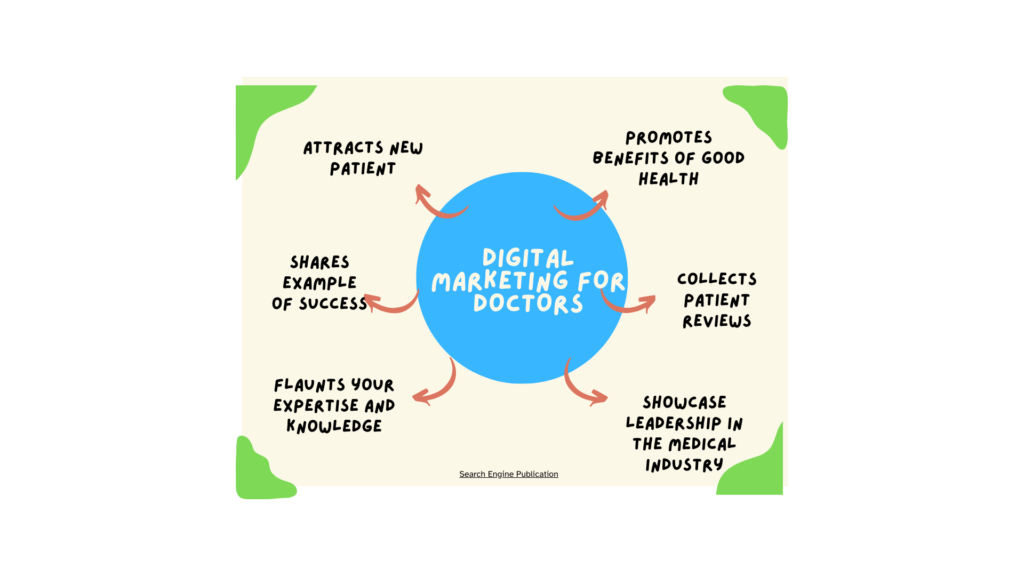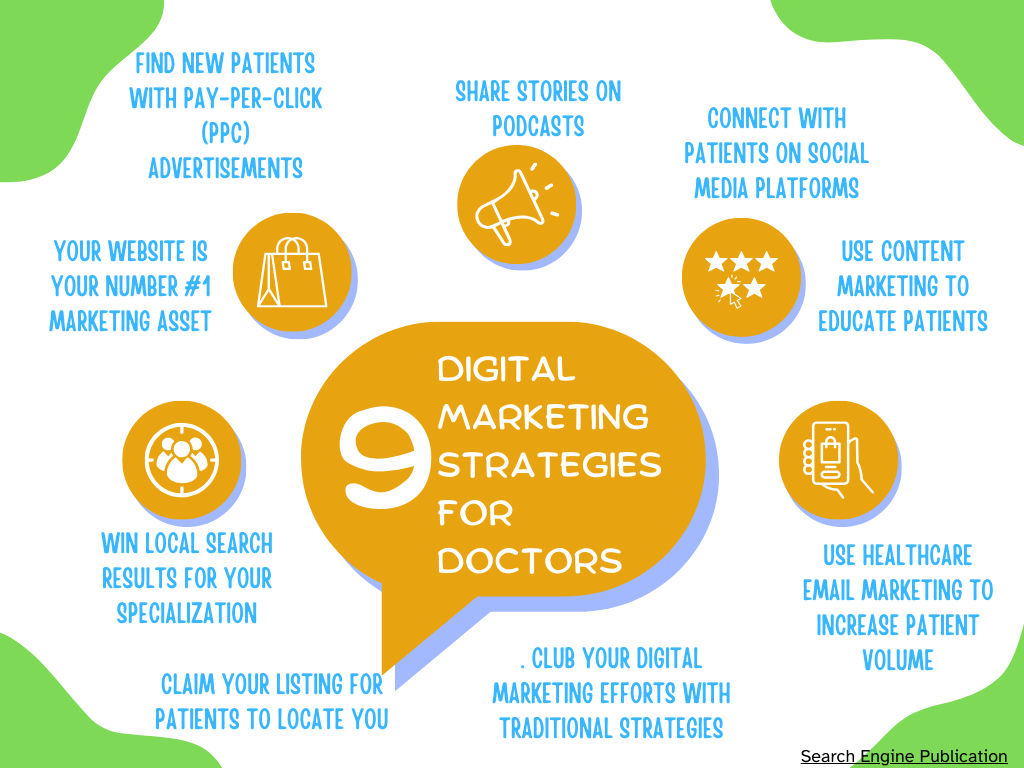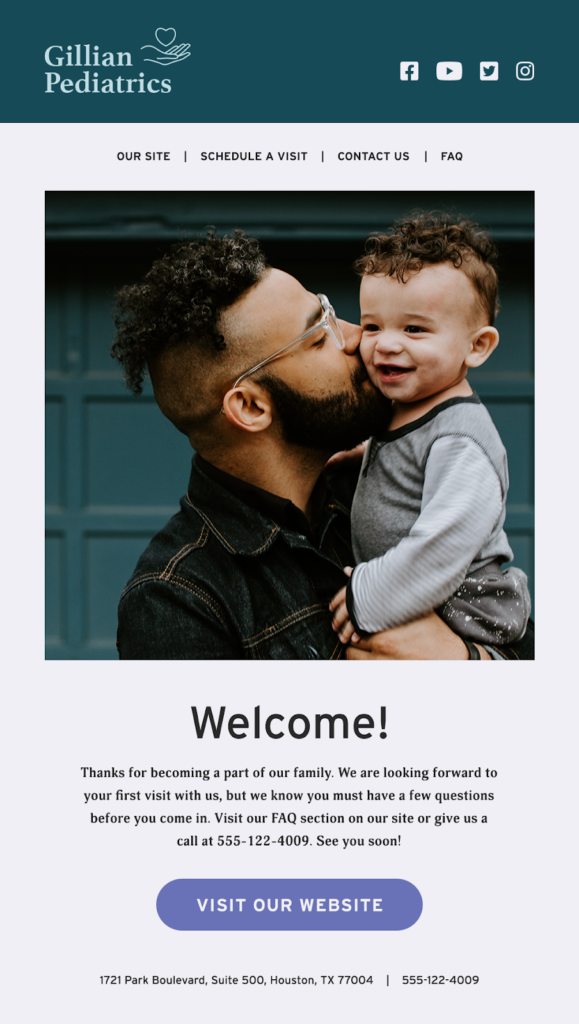If you think digital marketing is a luxury affordable only by Fortune 100 or 500 companies, get your stats right. It’s a necessity, not a luxury anymore. Why?
In the healthcare industry, word-of-mouth referrals will not get you enough patients.
Wake up, shake up, and smell the antiseptic because digital marketing for doctors is the new Yellow page of the internet. As you’re from a world that has spent most of its time digging books, the Wild West of digital marketing may seem an extra burden to your already overloaded schedule.
While digital marketing might seem challenging, you can create your strategy by emulating what others have done to achieve success.
Worry not, my dear medical friend, because we at Search Engine Publication will guide you on digital marketing strategies to boost your medical practice.
Why is digital marketing for doctors and medical professionals useful?
Digital marketing for doctors offers a great opportunity to promote your services and practices online. Your digital marketing aims to bring new patients to your clinic by creating a professional image that patients trust. When you feature on the top search engine results, patients feel more comfortable for a visit. Interestingly, it simultaneously increases your medical practice online and builds your reputation.

While these benefits might pop your eyes out for a second, you’re no digital marketing guru to crack the code of ranking on the top search results as a doctor or specialist. Ranking on search engines takes time, and you require a comprehensive digital marketing strategy to accomplish your goals.
Top 9 digital marketing strategies for medical practices
So, if you’re buckled to spend time, money, and resources on digital marketing for doctors, you need to know what will pay off. Here are some proven digital marketing tactics and strategies that put the ball in your court, patients:

1. Your website is your number #1 marketing asset
Did you know 81% of US adults use the internet, and 72% of those say they search online for health-related information?
This implies that you need a strong internet presence, and what’s better than your website? While there are many possible ways, the website gives you control over your patient’s experience.
A well-built, designed, and user-friendly website will likely attract potential patients. While investing in a website may seem costly, it offers very long-term benefits to healthcare organizations.
But does building “just” a website alone suffice? Probably no! You need a “mobile-friendly” website. The mobile-friendly design increases your online visibility. Even Google uses what we call “mobile-first indexing,” which means, by default, they primarily use the mobile version of a web page or website for indexing and search engine optimization (SEO) purposes.
Pro-tip: Remember, your offline practices need an online home.
2. Claim your listing for patients to locate you
Once your patients decide to schedule an appointment, they need to know where your clinic is located. That’s why local listing is an essential digital marketing strategy.
So, claim and verify your local listings on Google, Bing, and Yahoo search engines.
Search engines display your information when patients in your area search for healthcare services. Just imagine how convenient it is for someone needing medical attention to find your practice with just a few clicks!

However, if your listing doesn’t appear or the information displayed is incorrect, your potential patients may not find you. This reduces patient engagement, and they switch to another doctor.
Claiming and managing your listings does require some effort at first. Ensure your listings are accurate and up-to-date. While many listing services are free and can be managed independently, paid services are also available.
Pro-tip: Apart from claiming your listings and keeping them updated, use Google My Business to make it easier for your future patients to find you. After all, good healthcare should be accessible and easy to find, right?
3. Win local search results for your specialization
Medical or healthcare marketing is always local. It’s neither inter-state nor national. A patient in New York will seek a Gynecologist in New York, not Texas. So, optimizing your web pages for local search engine optimization is essential to attract more patients.
Securing a top spot in local search results for your doctor’s specialization requires a strategic approach. Here are the steps to follow:
- Optimize your profile: Use high-quality photos of your practice, your team, and yourself for your Google My Business account. These should be professional and inviting. Also, select the correct category for your business. If you’re a pediatrician, for example, make sure you select ‘Pediatrician’ as your category.
- Collect patient reviews: Encourage your existing patients to leave positive online reviews on your profile. Respond to these prospective patients’ reviews professionally and promptly, showing appreciation for their time and feedback. With 90% of patients reading online reviews to evaluate physicians, you cannot overlook the power of reviews.
- Update your information regularly: Keep your profile updated with any changes in operating hours, contact information, or services offered.
- Use local and relevant keywords: Incorporate keywords relevant to your practice and area into your website. This could include phrases like “Cardiologist in New York City” or “Family Doctor in Miami.”
- Focus on schema markup: Schema markup highlights essential information such as your operating hours, location, and the services you offer in the search results. This does not alter how your webpage looks to visitors, but it gives search engines more information about your webpage’s content.
To learn about other local SEO strategies, read our blog on restaurant SEO.
Pro-tip: Ignoring your local SEO is as good as not having an online presence.
4. Connect with patients on social media platforms
Connecting with existing and former healthcare professionals and potential patients on social media platforms like Instagram and Facebook is a delight. These platforms are like bustling digital marketplaces where you can share exciting news, updates, and insights about healthcare practices.
But remember, the secret ingredient to cooking up a thriving online presence is consistency, sprinkled with a dash of frequency. So, create a social media strategy.
Imagine your social media accounts as a television channel – your followers would love to see new ‘episodes’ regularly. So, make it a point to post engaging and relevant content on your social media channels like Twitter or Instagram accounts multiple times a day.
Think about sharing behind-the-scenes glimpses of your medical practice, health tips, patient success stories, or even a simple day. The goal is to create a friendly, informative space that resonates with your audience.
Here’s how a dermatologist is nailing reels and trends on Instagram to attract new and existing patients:

He regularly uploads reels and videos on skincare routines to build a connection with his followers.
That’s how you need to nail your social media marketing campaigns.
Pro-tip: Remember, every post is a unique opportunity to showcase your medical practice experience and connect with your community meaningfully.
5. Use healthcare email marketing to increase patient volume
With email marketing, you keep in regular touch with your patients. Imagine sending out routine information, such as appointment reminders, with just a click. But the magic of email marketing goes beyond that.
Transform your emails into a virtual health magazine, sending out engaging newsletters filled with health tips, updates about your healthcare practice, and announcements of upcoming events. A new communication channel opens when your patients opt in to receive these newsletters. This allows you to stay connected with your patients, even those who don’t need to visit your office regularly.
Here’s an example of healthcare email marketing:

Frequent and meaningful communication builds a stronger bond between you and your patients. When they receive valuable health tips and updates from you, it builds trust and appreciation.
Over time, this retains your existing ones and attracts new patients.
Pro-tip: Stay in the minds of your patients through emails because it helps you become their first choice when they or their loved ones need care.
6. Club your digital marketing efforts with traditional strategies
Traditional marketing strategies like print ads and billboards are incredibly effective. They capture the attention of your local target audience.
Before giving print ads in a newspaper or magazine, ensure your target audience reads it. For instance, if you’re a pediatrician, a local magazine targeted toward parents of young children attracts new patients. But, for an orthopedic surgeon, this is not the right magazine.
On the other hand, billboards offer a wider reach but are challenging when targeting a specific audience. You never really know who might drive by.
Your traditional marketing efforts strengthen your digital marketing strategies.
Although the latter increases the possibility of finding more people, the former helps make a positive impression in your local community, ensuring a well-rounded healthcare marketing strategy.
So, while focusing on the digital age, let’s not forget the power of traditional marketing tactics.
Pro-tip: Find the right balance to engage with your patients online and offline.
7. Use content marketing to educate patients
When marketing for doctors and creating a medical marketing plan, focus on creating content.
As the healthcare industry is a labyrinth of complex terminologies, processes, and procedures, sharing your expertise with your patients guides them through this maze.
Email marketing, blog articles, and webinars are excellent tools to build patient trust and confidence. Use these platforms as your digital classroom where you clarify common queries and share valuable information.
And while you’re at it, don’t forget to sprinkle in plenty of relevant keywords. This makes your content more searchable and increases your Google ranking. The result?
More visibility online and an increased chance of connecting with potential patients.
Another content marketing strategy is using videos. Though they require more planning and resources, they are worth every effort. With videos generating up to 66% more qualified leads, make videos a critical part of your online marketing strategy.
So, consider incorporating videos into your content strategy wherever possible. Think of them as interactive tutorials or virtual tours that breathe life into your medical practice.
Pro-tip: Content is and will always remain the king, queen, and everything regarding digital marketing for doctors.
8. Find new patients with pay-per-click (PPC) advertisements
PPC is a handy tool where you pay a small fee every time someone clicks on your online ad.
PPC can be a real game-changer if you’re a doctor or a healthcare professional. It attracts a whole bunch of potential patients for you.
However, it’s worth noting that while PPC can offer immediate results, organic traffic remains highly desirable and typically holds more value in the long run. Nevertheless, while organic traffic builds over time, paid advertising, such as PPC, can immediately boost your digital marketing strategies. This can be particularly useful for medical practitioners looking to increase their online visibility and attract new patients quickly.
Here’s what a PPC ad looks like:

Several platforms are available for implementing PPC campaigns, with Google and Bing being the most popular ones. Like SEO, these platforms allow medical practices to target specific keywords and geographical areas. This targeting is achieved by outbidding competitors for the desired keywords, ensuring your ads appear before the organic search results. This positional advantage increases your online visibility and elevates patient engagement.
Doctors can use social media advertising. For instance, Facebook Ads allow a medical practice to create highly targeted audiences based on data collected from users’ profiles and online behaviors.
Given that PPC ads involve costs for each click, it is critical to invest wisely. T
Pro-tip: Thorough research should be conducted to identify keywords that offer the highest return on investment. Doing so can ensure maximum results without prematurely depleting your budget.
9. Share stories on podcasts
Everybody loves a good story. There’s nothing quite like a narrative that captures the human spirit, filled with emotions, plot twists, and characters we can relate to. It’s these stories that grab our attention and stick with us.
Take Kevin Pho’s The Podcast by KevinMD, for example. This isn’t just any podcast; it’s a platform where doctors, nurses, medical students, and even patients get to share their unique insights and experiences. It’s a place where stories come alive, and let me tell you, these stories are powerful.
The beauty is that Kevin can reach a huge online audience, sharing insights into different facets of the healthcare industry and spreading important messages far and wide. And guess what? You can do this too!
Why not use this strategy and start sharing stories from your colleagues or patients (with their permission)? Or how about sharing your own experiences? The key here is to find and highlight the human element in each story.
For instance, don’t just discuss the medical terms if you’re discussing a particular diagnosis. Dive deeper. Talk about how it could impact someone’s everyday life. Encourage your audience to imagine their grandmother, child, or even themselves in the heart of your story. By doing this, you share a medical condition and a human experience.
Pro-tip: Once you start telling stories this way, you won’t just be successful; you’ll make a real difference. So, search for Podcasts or YouTube channels where you can share your stories with others.
The future for doctors is digital marketing
Digital marketing for doctors is always changing and growing. To keep your practice thriving, gain trust, and attract potential patients, update your marketing knowledge and craft unique strategies that fit your medical practice like a glove.
Here’s a friendly reminder: every time you add a new digital marketing campaign to your toolkit, don’t forget to test it, test it again, and yes, test it one more time! This way, you can ensure that every aspect of your campaign is optimized just right.
So there you have it! Eight proven digital marketing tips for doctors. But remember, the key to successful marketing is continuous learning and adaptation. So, keep exploring, keep learning, and keep growing your practice. You’ve got this!


